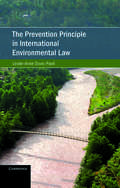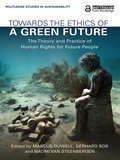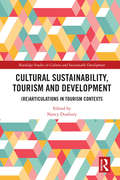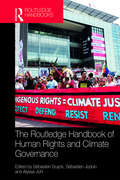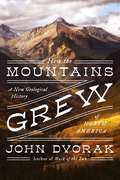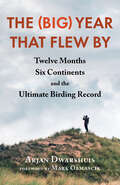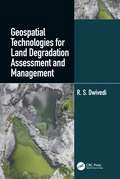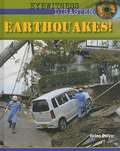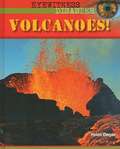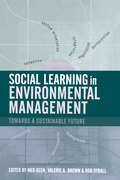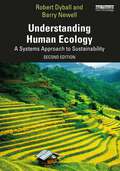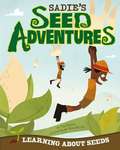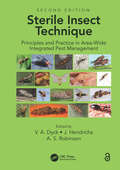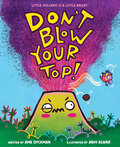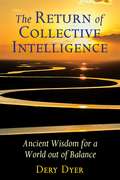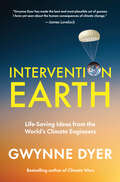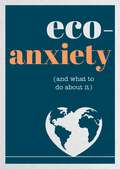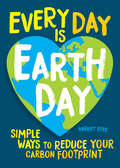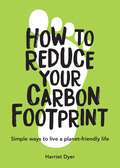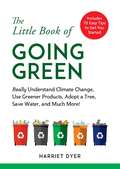- Table View
- List View
A Bear's Year
by Kathy Duval Gerry TurleyIn this gorgeous, lyrical celebration about the passing of seasons, readers will follow a mother bear and her cubs through the course of a year. Deep in her den under a snowflake blanket, Mama snuggles her newborn babies. When spring arrives, the bears awaken and emerge from their lair, and as the weather warms to summer, Mama teaches her young ones to fish, gather berries, and dig for roots. Then, in fall, the leaves turn gold, food grows scarce, and the family prepares for hibernation and the coming winter. With spare, accessible text and charming illustrations, here is a sweet, gentle introduction to how bears experience the changing seasons, perfect for the youngest readers and listeners.
The Prevention Principle in International Environmental Law (Cambridge Studies On Environment, Energy And Natural Resources Governance )
by Duvic-Paoli Leslie-AnnePrevention is recognized as a cornerstone of international environmental law, but this principle remains abstract and elusive in terms of exactly what is required of states to prevent environmental harm. <P><P>In this illuminating work, Leslie-Anne Duvic-Paoli addresses this issue by offering a systematic, comprehensive assessment in which she clarifies the rationale, content, and scope of the prevention principle while also placing it in a wider legal context. <P>The book offers a detailed analysis of treaty law, custom codification works, and case law before culminating in a conceptualization of prevention based on three definitional traits: 1. Its anticipatory rationale; 2. Its due diligence content; and 3. Its wide spatial scope to protect the environment as a whole. This book should be read by anyone seeking to understand the evolving principle of prevention in international environmental law, and how it increasingly shares common ground with reparation in the arena of compliance control.<P> Provides a systematic and up-to-date treatment of the principle of prevention, widely considered to be the cornerstone of international environmental law.<P> Undertakes a comprehensive review of the manifestations of prevention in conventional law, custom codification works, and case law.<P> Seeks to understand prevention, and its evolution, in the context of general international law trends.
Towards the Ethics of a Green Future: The Theory and Practice of Human Rights for Future People (Routledge Studies in Sustainability)
by Marcus Düwell Gerhard Bos Naomi Van SteenbergenWhat are our obligations towards future generations who stand to be harmed by the impact of today’s environmental crises? This book explores ecological sustainability as a human rights issue and examines what our long-term responsibilities might be. This interdisciplinary collection of chapters provides a basis for understanding the debates on the provision of sustainability for future generations from a diverse set of theoretical standpoints. Covering a broad range of perspectives such as risk and uncertainty, legal implementation, representation, motivation and economics, Towards the Ethics of a Green Future sets out the key questions involved in this complex ethical issue. The contributors bring theoretical discussions to life through the use of case studies and real-world examples. The book also includes clear and tangible recommendations for policymakers on how to put the suggestions proposed within the book into practice. This book will be of great interest to all researchers and students concerned with issues of sustainability and human rights, as well as scholars of environmental politics, law and ethics more generally.
Cultural Sustainability, Tourism and Development: (Re)articulations in Tourism Contexts (Routledge Studies in Culture and Sustainable Development)
by Nancy DuxburyCultural Sustainability, Tourism and Development considers how tourism provides a lens to examine issues of cultural sustainability and change. It discusses how cultural and natural assets, artistic interventions, place identity, policy strategies, and community well-being are intertwined in (re)articulations of place and local dynamics that occur in tourist locations. With a primary focus on culture in sustainable development, the book clarifies connections between culture as a core dimension of local sustainability and cultural dimensions of sustainable tourism. It highlights the roles and place of cultural expression, artistic activity, and heritage resources in local or regional sustainable development contexts. Chapters critically examine the dimensions of tourism-invoked dynamics of change and the cultural impacts of tourism-related activities. The book concludes with proposals for new culture-informed and creativity-based approaches, mediations, and relations to encourage a better balance between visitors and residents’ quality of life and the broader sustainability of the area. Interdisciplinary and international in scope, contributions reflect on communities and rural areas located in Brazil, Canada, Croatia, India, Italy, Japan, the Netherlands, Poland, Portugal, and the United States. This book will be of great interest to students and scholars of cultural development and policy, heritage studies, cultural tourism and sustainable tourism, cultural geography, and regional development.
Routledge Handbook of Human Rights and Climate Governance (Routledge International Handbooks)
by Sébastien Duyck Sébastien Jodoin Alyssa JohlOver the last decade, the world has increasingly grappled with the complex linkages emerging between efforts to combat climate change and to protect human rights around the world. The Paris Climate Agreement adopted in December 2015 recognized the necessity for governments to take into consideration their human rights obligations when taking climate action. However, important gaps remain in understanding how human rights can be used in practice to develop and implement effective and equitable solutions to climate change at multiple levels of governance. This book brings together leading scholars and practitioners to offer a timely and comprehensive analysis of the opportunities and challenges for integrating human rights in diverse areas and forms of global climate governance. The first half of the book explores how human rights principles and obligations can be used to reconceive climate governance and shape responses to particular aspects of climate change. The second half of the book identifies lessons in the integration of human rights in climate advocacy and governance and sets out future directions in this burgeoning domain. Featuring a diverse range of contributors and case studies, this Handbook will be an essential resource for students, scholars, practitioners and policy makers with an interest in climate law and governance, human rights and international environmental law.
How the Mountains Grew: A New Geological History of North America
by John DvorakThe incredible story of the creation of a continent—our continent— from the acclaimed author of The Last Volcano and Mask of the Sun.The immense scale of geologic time is difficult to comprehend. Our lives—and the entirety of human history—are mere nanoseconds on this timescale. Yet we hugely influenced by the land we live on. From shales and fossil fuels, from lake beds to soil composition, from elevation to fault lines, what could be more relevant that the history of the ground beneath our feet? For most of modern history, geologists could say little more about why mountains grew than the obvious: there were forces acting inside the Earth that caused mountains to rise. But what were those forces? And why did they act in some places of the planet and not at others? When the theory of plate tectonics was proposed, our concept of how the Earth worked experienced a momentous shift. As the Andes continue to rise, the Atlantic Ocean steadily widens, and Honolulu creeps ever closer to Tokyo, this seemingly imperceptible creep of the Earth is revealed in the landscape all around us. But tectonics cannot—and do not—explain everything about the wonders of the North American landscape. What about the Black Hills? Or the walls of chalk that stand amongst the rolling hills of west Kansas? Or the fact that the states of Washington and Oregon are slowly rotating clockwise, and there a diamond mine in Arizona? It all points to the geologic secrets hidden inside the 2-billion-year-old-continental masses. A whopping ten times older than the rocky floors of the ocean, continents hold the clues to the long history of our planet. With a sprightly narrative that vividly brings this science to life, John Dvorak's How the Mountains Grew will fill readers with a newfound appreciation for the wonders of the land we live on.
The (Big) Year that Flew By: Twelve Months, Six Continents, and the Ultimate Birding Record
by Arjan Dwarshuis"A fast-paced page-turner and a unique adventure story . . . filled with insights about landscapes, people, and a world of wonderful birds.”―Kenn Kaufman, author of Kingbird Highway An epic tale of one passionate birder’s record-breaking adventure through 40 countries over 6 continents—in just one year—to see 6,852 bird species, rare and common, before many go extinct. When Arjan Dwarshuis first heard of the “Big Year”—the legendary record for birdwatching—he was twenty years old, it was midnight, and he was sitting on the roof of a truck in the Andean Mountains. In that moment he promised himself that, someday, somehow, he would become a world-record-holding birder. Ten years later, he embarked on an incredible, arduous, and perilous journey that took him around the globe; over uninhabited islands, through dense unforgiving rainforests, across snowy mountain peaks and unrelenting deserts—in just a single year. Would he survive? Would he be able to break the “Big Year” record, navigating through a world filled with shifting climate and geopolitical challenges? The (Big) Year that Flew By is an unforgettable, personal exploration of the limits of human potential when engaging with the natural world. It is a book about birds and birding and Arjan’s attempts to raise awareness for critically endangered species, but it is also a book about overcoming mental challenges, extreme physical danger, and human competition and fully realizing your passions through nature, adventure, and conservation. "Dwarshius’ exhilarating race against time across 40 countries and 6 continents in his attempt to break the world record will thrill armchair readers and bird enthusiasts alike."―Booklist
Geospatial Technologies for Land Degradation Assessment and Management
by R. S. DwivediThe constant growth of the world’s population and the decline of the availability of land and soil resources are global concerns for food security. Other concerns are the decrease in productivity and delivery of essential ecosystems services because of the decline of soil quality and health by a range of degradation processes. Key soil properties like soil bulk density, organic carbon concentration, plant available water capacity, infiltration rate, air porosity at field moisture capacity, and nutrient reserves, are crucial properties for soil functionality which refers to the capacity of soil to perform numerous functions. These functions are difficult to measure directly and are estimated through indices of soil quality and soil health. Soil degradation, its extent and severity, can also be estimated by assessing indices of soil quality and health. "Geospatial Technology for Land Degradation Assessment and Management" uses satellite imagery and remote sensing technologies to measure landscape parameters and terrain attributes. Remote sensing and geospatial technologies are important tools in assessing the extent and the severity of land and soil degradation, their temporal changes, and geospatial distribution in a timely and cost-effective manner. The knowledge presented in the book by Dr. R.S. Dwivedi shows how remote sensing data can be utilized for inventorying, assessing, and monitoring affected ecosystems and how this information can be integrated in the models of different local settings. Through many land degradations studies, land managers, researchers, and policymakers will find practical applications of geospatial technologies and future challenges. The information presented is also relevant to advancing the Sustainable Development Goals of the United Nations towards global food security.
Meet the Candidates 2020: A Voter's Guide (Meet the Candidates 2020)
by Scott Dworkin Grant SternGet informed about the campaign issues and policies of Democratic candidate Elizabeth Warren, the populist, progressive, definitively capitalist senator from Massachusetts.Meet the Candidates 2020: Elizabeth Warren: A Voter’s Guide will help you decide quickly if Warren deserves your vote for the Democratic nomination and to take on Donald Trump for president of the United States. Warren’s strong economic background sets her apart; the senator from Massachusetts defines herself as a capitalist first and seeks to make capitalism more equitable for all. She has already proposed sweeping anti-corruption reforms, refused PAC donations to her campaign, rolled out plans for college debt forgiveness and a tax on the super wealthy. Her background as a Harvard economist, author of TheTwo-Income Trap, and experience as an economic advisor to Barack Obama positions her well to make change happen. Warren’s campaign also features popular Democratic talking points—rebuilding the middle class, ending corruption in Washington, making voting laws more democratic, bringing our troops home and stopping endless war—but it’s her experience that sets her apart. From working the campaign trial for Hillary Clinton to weathering President Trump’s refrain of “Pocahontas” in reference to her claimed Native American heritage, Meet the Candidates 2020: Elizabeth Warren: A Voter’s Guide is your complete handbook to Elizabeth Warren’s resumé, campaign, and what America would look like if she won the presidency in 2020.The Meet the Candidates 2020 series is the informed voter’s guide to making a decision in the 2020 Democratic primary and presidential election. Each book gives an unbiased, political insider’s analysis of each contender, featuring: candidate interviews; an introduction by campaign advisor, Democratic Coalition co-founder, and Dworkin Report host Scott Dworkin; and compilation and writing by Occupy Democrats Editor at Large Grant Stern. In two hours of reading, you’ll understand their defining characteristics, credentials, campaign issues, challenges, presidential chances, and everything else you need to know to decide who should challenge Donald Trump. Whether it’s for Elizabeth Warren, Joe Biden, Bernie Sanders, Kamala Harris, Julian Castro, Cory Booker, or another, Meet the Candidates is what you need to make an informed vote for president in 2020.
Meet the Candidates 2020: A Voter's Guide (Meet the Candidates 2020)
by Scott Dworkin Grant SternWhat is “democratic socialism?" Educate yourself on Bernie Sanders, the liberal independent from Vermont and the 2016 underdog turned 2020 Democratic favorite. Bernie Sanders shocked the establishment in 2016 with his self-described “political revolution,” mobilizing grassroots fundraising and campaigning to nearly secure the Democratic nomination over Hillary Clinton (even in the face of Democratic National Convention opposition). The Vermont senator and longest-serving independent in congressional history hopes to do the same with a better result in 2020. Meet the Candidates 2020: Bernie Sanders: A Voter’s Guide will help you decide if Sanders’s brand of democratic socialism is for you and if he is the right candidate to take on Donald Trump.A vocal critic of Donald Trump, Sanders advocates for sweeping reform: single-payer, universal health care, labor and economic inequality reform, taxes on the wealthy, the Green New Deal, marijuana legalization, free higher education. Sanders has had an undeniable influence on how campaigns are run and has moved the Democratic party to the left, but how will his liberal platforms play in a Democratic primary and against Trump in a general election? After reading Meet the Candidates 2020: Bernie Sanders: A Voter’s Guide you’ll be able to analyze those chances, explain his positions, and decide if they are what you believe is right for America. The Meet the Candidates 2020 series is the informed voter’s guide to making a decision in the 2020 Democratic primary and presidential election. Each book gives an unbiased, political insider’s analysis of each contender, featuring: candidate interviews; an introduction by campaign advisor, Democratic Coalition co-founder, and Dworkin Report host Scott Dworkin; and compilation and writing by Occupy Democrats Editor at Large Grant Stern. In two hours of reading, you’ll understand their defining characteristics, credentials, campaign issues, challenges, presidential chances, and everything else you need to know to decide who should challenge Donald Trump. Whether it’s for Elizabeth Warren, Joe Biden, Bernie Sanders, Kamala Harris, Julian Castro, Cory Booker, or another, Meet the Candidates is what you need to make an informed vote for president in 2020.
Meet the Candidates 2020: A Voter's Guide (Meet the Candidates 2020)
by Scott Dworkin Grant SternKamala Harris is already a contender to take on Donald Trump despite still refining her positions. Learn what makes the lawyer, legislator, and progressive Democrat a strong candidate.Meet the Candidates 2020: Kamala Harris: A Voter’s Guide is your handbook to understanding the candidacy of Kamala Harris and deciding if she deserves your vote in the Democratic primary, and ultimately to take on Donald Trump in the 2020 presidential election.The senator, former prosecutor, and attorney general from California has gained momentum after a strong national showing at the Kavanaugh hearings. She is a strong voice in the Senate, and serves on the Homeland Security and Governmental Affairs Committee, the Select Committee on Intelligence, the Committee on the Judiciary, and the Committee on the Budget. While she is still refining her campaign stances, she has voiced support for gun control, the Green New Deal, lowering middle class taxes, DREAMers, net neutrality, and legalizing marijuana. Meet the Candidates 2020: Kamala Harris: A Voter’s Guide examines how her campaign will solidify, the type of leader she’ll be, and her chances versus Donald Trump in the general election.The Meet the Candidates 2020 series is the informed voter’s guide to making a decision in the 2020 Democratic primary and presidential election. Each book gives an unbiased, political insider’s analysis of each contender, featuring: candidate interviews; an introduction by campaign adviser, Democratic Coalition co-founder, and Dworkin Report host Scott Dworkin; and compilation and writing by Occupy Democrats Editor at Large Grant Stern. In two hours of reading, you’ll understand their defining characteristics, credentials, campaign issues, challenges, presidential chances, and everything else you need to know to decide who should challenge Donald Trump. Whether it’s for Elizabeth Warren, Joe Biden, Bernie Sanders, Kamala Harris, Julian Castro, Cory Booker, or another, Meet the Candidates is what you need to make an informed vote for president in 2020.
Earthquakes!
by Helen DwyerProvides information about earthquakes through eyewitness accounts from survivors and rescue workers
Volcanoes!
by Helen DwyerProduces the facts on volcanoes, like what is a volcano, where they are found, and basic information on the same
Social Learning in Environmental Management: Towards a Sustainable Future
by Rob Dyball Meg KeenSocial Learning in Environmental Management explores and expands the approaches to collective learning most needed to help individuals, communities, experts and governments work together to achieve greater social and ecological sustainability. It provides practical frameworks and case studies to assist environmental managers in building partnerships that can support learning and action on issues arising from human impacts on the life-support systems of our planet. In this book, social learning frameworks and case studies address the three areas of collaboration, community, government and professional, in some detail. The resulting guidelines and their practical applications provide key source material for undergraduate and postgraduate professional education in the fields of social and environmental sciences, political science, planning, geography and urban studies, and also for professionals in environmental management.
Understanding Human Ecology: A Systems Approach to Sustainability
by Robert Dyball Barry NewellUnderstanding Human Ecology offers a coherent conceptual framework for human ecology – a clear approach for understanding the many systems we are part of and for how we frame and understand the problems we face. Blending natural, social, and cognitive sciences with dynamical systems theory, this key text offers systems approaches that are accessible to all, from the undergraduate student to policymakers and practitioners across government, business, and community. In the first edition, road-tested and refined over a decade of teaching and workshops, the authors built a clear, inspiring, and important framework for anyone approaching the management of complex problems and the transition to sustainability. Fully updated for the second edition, the book now goes further in using systems-thinking principles to explain fundamental processes of change in social–ecological systems. Revised case examples provide a working application of these principles, whilst a new discussion of the hierarchical structure of complex systems is included to guide practical policymaking. This new edition is essential reading for students and scholars of human ecology, environmental ethics, and sustainability studies.
Sadie's Seed Adventures: Learning About Seeds
by Tina DybvikSadie and Gardener Marv set out to clear weeds from a garden plot. While working, they go on a magical adventure to learn all about seeds. From hitching a ride with a cocklebur to flying through the sky with a milkweed seed, join Sadie as she figures out how seeds disperse.
Sterile Insect Technique: Principles And Practice In Area-Wide Integrated Pest Management
by V. A. DyckThe sterile insect technique (SIT) is an environment-friendly method of pest control that integrates well into area-wide integrated pest management (AW-IPM) programmes. This book takes a generic, thematic, comprehensive, and global approach in describing the principles and practice of the SIT. The strengths and weaknesses, and successes and failures, of the SIT are evaluated openly and fairly from a scientific perspective. The SIT is applicable to some major pests of plant-, animal-, and human-health importance, and criteria are provided to guide in the selection of pests appropriate for the SIT. In the second edition, all aspects of the SIT have been updated and the content considerably expanded. A great variety of subjects is covered, from the history of the SIT to improved prospects for its future application. The major chapters discuss the principles and technical components of applying sterile insects. The four main strategic options in using the SIT — suppression, containment, prevention, and eradication — with examples of each option are described in detail. Other chapters deal with supportive technologies, economic, environmental, and management considerations, and the socio-economic impact of AW-IPM programmes that integrate the SIT. In addition, this second edition includes six new chapters covering the latest developments in the technology: managing pathogens in insect mass-rearing, using symbionts and modern molecular technologies in support of the SIT, applying post-factory nutritional, hormonal, and semiochemical treatments, applying the SIT to eradicate outbreaks of invasive pests, and using the SIT against mosquito vectors of disease. This book will be useful reading for students in animal-, human-, and plant-health courses. The in-depth reviews of all aspects of the SIT and its integration into AW-IPM programmes, complete with extensive lists of scientific references, will be of great value to researchers, teachers, animal-, human-, and plant-health practitioners, and policy makers.
Don't Blow Your Top!
by Ame DyckmanEverybody gets angry sometimes, even a little volcano. But with some rock-steady advice, Little Volcano finds a way to process their steamy emotions.Spend a day in paradise with Little Volcano and Big Volcano. Everything is beautiful and calm until an out-of-control bird drops a coconut on Little Volcano's crater. Will Little Volcano blow their top? Can Big Volcano help? Don't Blow Your Top! is a hysterical and explosive read-aloud story that will have kids of all ages erupting with laughter as Little Volcano and Big Volcano try to deal with their anger and go with the flow. The book features some tips for kids and volcanoes of all ages to help them navigate their fiery emotions and learn to be cool when things get a little out of control.
Mi mejor sueño ¡LOS CABALLOS!
by Ginny Suess DyeMi mejor sueño ¡LOS CABALLOS! Autor: Ginny & Suess Dye Ilustrador: Iqra Abdullah Sueños para la hora de dormir Serie# 1 Más de la serie de libros ¡Cuando sueño, sueño con cachorritos! ¡Cuando sueño, sueño con LODO, LODO, LODO! Cuando sueño, sueño con gatitos Cuando sueño, sueño con elefantes Cuando sueño, sueño con pájaros Cuando sueño, sueño con nieve Cuando sueño, sueño con el océano Cuando sueño, sueño con la jungla Cuando sueño, sueño con una granja Cuando sueño, sueño con postres Y MUCHOS más… Copyright 2017 por Greywacke Publishing ISBN# 1974095592 Publicado por Greywacke Publishing Seattle, WA www.MyBestEverDreams.com www.GreyWackePublishing.com
The Return of Collective Intelligence: Ancient Wisdom for a World out of Balance
by Dery DyerReveals how we can each reconnect to collective intelligence and return our world to wholeness, balance, and sanity • Explains how collective intelligence manifests in flocks of birds, instantaneous knowing in indigenous peoples, and the power of sacred places • Offers ways for us to reconnect to the infinite source of wisdom that fuels collective intelligence and underscores the importance of ceremony, pilgrimage, and initiation • Draws on recent findings in New Paradigm science, traditional teachings from indigenous groups from North, South, and Central America and Siberia, as well as sacred geometry, deep ecology, and expanded states of consciousness For our ancestors, collective intelligence was a normal part of life. We see it today as the mysterious force that enables flocks of birds, swarms of bees, and schools of fish to function together in perfect synchrony, communicating and cooperating at some undetectable level. At its most subtle, it&’s an instantaneous knowing, shared by members of a group, of the wisest course of action that will benefit all. As Dery Dyer reveals, collective intelligence still resides within each of us, and it is the key to restoring balance and harmony to our world. She shows how it occurs spontaneously when individuals who share a need and a purpose instinctively &“self-organize&” into a group and function with no leader or central authority. Such groups exhibit abilities much greater than what any of their members possess individually--or what can be replicated with artificial intelligence. Dyer explains, due to an unquestioning dependence on technology, modern humanity has forgotten how to connect with collective intelligence and fallen into collective stupidity, otherwise known as mob mind or groupthink, which is now endangering the interconnected web of life on Earth. Drawing on recent findings in New Paradigm science, traditional teachings from indigenous groups, as well as sacred geometry, deep ecology, and expanded states of consciousness, the author shows how the ability to think and act collectively for the highest good is hardwired in all living beings. She explains how to release ourselves from enslavement by technology and use it more wisely toward the betterment of all life. Underscoring the vital importance of ceremony, pilgrimage, and initiation, she offers ways for us to reconnect to the infinite source of wisdom that fuels collective intelligence and which manifests everywhere in the natural world. Revealing that once we relearn how to hear the Earth, we can heal the Earth, Dyer shows how each of us has a vital role to play in restoring our world to wholeness.
Intervention Earth: Life-Saving Ideas from the World's Climate Engineers
by Gwynne DyerHistorian, journalist, and author Gwynne Dyer interviews the world&’s top 100 climate scientists to discuss the extraordinary measures we must contemplate to counter the irreversible effects of climate change.The global climate emergency is now an alarming fact of life. Much as we still need to get emissions under control, many are thinking that it's all too little, too late. As scientists, politicians and concerned citizens scramble for solutions to the catastrophic effects of a warming world, is it time to be exploring the controversial topic of geoengineering?For decades, discerning readers have turned to journalist and historian Gwynne Dyer for his unparalleled acumen in serving up hard geopolitical truths. Intervention Earth is built around Dyer&’s interviews with one hundred climate scientists from around the globe, including the leading figures in the geoengineering field. One of the most interesting topics: the pros and cons of Solar Radiation Management, a possible planetary Hail Mary that is rife with political risks.But Intervention Earth is about more than technological mega-projects. Dyer devotes ample space to the many innovative ideas on offer, but there is no get-out-of-jail-free card. We will need a whole portfolio of techniques and technologies—and a lot of hard, thankless work—to keep the planet hospitable for humanity.What&’s more, many of the technologies that can help us avoid the worst outcomes require years of investment and development before they can be successfully deployed. Global cooperation will be key in implementing the life-saving strategies outlined in the book. With up-to-the-minute, breaking-news reporting Intervention Earth offers a probing, eye-opening look at the problems we face, and the innovations that just might keep us ahead of encroaching disaster and carry us to a safe harbour.
Eco-Anxiety (and What to Do About It): Practical Tips to Allay Your Fears and Live a More Environmentally Friendly Life
by Harriet DyerBe kind to the planet, but most of all, be kind to yourselfWhen you feel the weight of the world on your shoulders, grab this book for a dose of calm and courage. Packed with reassuring tips and advice, from mindfulness exercises to practical steps you can take to make a difference, this guide will ease your eco-anxiety and help you to live a more environmentally friendly life.
Every Day Is Earth Day: Simple Ways to Reduce Your Carbon Footprint
by Harriet DyerFast facts on fast fashion, throwaway plastics, and other climate catastrophes that you can do something about—today. Every Day Is Earth Day is full of simple ways to reduce your environmental impact. From tips on creating a more eco-friendly home and ways to reduce your plastic use, to advice on shopping sustainably, within these pages you will discover everything you need to know to help you make planet-friendly choices and live a more sustainable life. Also included are tips on taking it to the next level and becoming an activist—to effect wider change and encourage businesses and governments to create a future that&’s healthier, safer, and cleaner!
How to Reduce Your Carbon Footprint: Simple Ways to Live a Planet-Friendly Life
by Harriet DyerDo you ever feel overwhelmed by the thought of the climate emergency?Do you want an eco-friendly lifestyle but don’t know where to start?Then dive into this little book, full of simple, achievable ways to help you reduce your carbon footprint. From tips on creating a more eco-friendly home and ways to reduce your plastic use, to advice on shopping sustainably, within these pages you will discover everything you need to know to help you make planet-friendly choices and live a more sustainable life.
The Little Book of Going Green: Really Understand Climate Change, Use Greener Products, Adopt a Tree, Save Water, and Much More! (The\little Book Of Ser.)
by Harriet Dyer“We have forgotten how to be good guests, how to walk lightly on the earth as its other creatures do.” —Barbara Wood The Little Book of Going Green aims to shed light on the ways humans are harming the environment, from pollution and deforestation to industrial production and farming methods. Before we can fix a problem, we must have a basic understanding of what brought us there in first place. Dyer explores past events and actions before directing our attention to the future through the exploration of how climate change has been affected by:PlasticsFossil FuelsIndustrial AgricultureDeforestationHuman Population In addition, Dyer explores how we can easily practice sustainability and conservation on both individual and corporate levels, creating habits at home that we can then bring to our workplaces. How can we reduce plastic waste in our homes? How can we reduce our carbon footprint in the office? Filled with facts, theories, and tips on how we can do our bit for the planet, this is your one-stop guide to making every aspect of your life earth-friendly.

